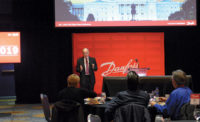Two major HVAC industry organizations have weighed in on a U.S. Department of Energy (DOE) proposal that would phase out noncondensing gas furnaces for consumer use beginning in about six years.
In letters to Julia Hegarty, an engineer in the DOE’s Building Technologies Office, the Air Conditioning Contractors of America (ACCA) strongly opposed a phase-out, while the Air Conditioning Heating and Refrigeration Institute (AHRI), which represents manufacturers, offered a mild, and qualified, endorsement.
The written remarks came just before the DOE closed a period of public comment on its plan to require a minimum annual fuel utilization efficiency standard of 95% for non-weatherized, gas-fired furnaces. If adopted, the rule would mean an eventual ban on noncondensing furnaces and would steer consumers toward condensing furnaces, which typically have AFUE ratings of 95% or greater, and electric home heating equipment such as heat pumps.
DOE Decision Next Year
DOE deputy press secretary Jeremy Paul Ortiz said public comments will be considered as the department decides on a final rule, which a court order requires it to do no later than next September 30. New standards, if adopted, would apply to furnaces manufactured in the U.S., or imported, starting five years after the date the rule is published.
The DOE is also considering a rule that would limit furnaces to drawing 8.5 watts of electricity when they are off or in standby mode, a move AHRI opposes.
According to a DOE analysis, the estimated energy savings, reduction in greenhouse gas (GHG) emissions, and health benefits of the proposed standards would greatly outweigh the costs. The standards would mean $536 million per year in increased equipment costs, the DOE said, but would annually yield $1.48 billion in reduced operating costs, nearly $1.04 billion in climate benefits, and $785 million in health benefits.
The DOE also said that a consumer who replaces a non-condensing furnace with a condensing model could save about $60 a year in utility costs, and that the proposed standards would reduce CO2 emissions by 373 million metric tons over 30 years.
CEO and president, ACCA
ACCA: Consumers Would Be Hurt
In his letter, ACCA’s president and CEO, Barton James, said that condensing furnaces have to be vented differently than noncondensing models, requiring building modifications that will end up costing consumers. In some types of housing, such as townhouses or row houses, building limitations may rule out horizontal venting, he said, and some building codes may prohibit horizontal venting as well.
“Consumers, especially those in lower income brackets, often times do not have the luxury of worrying about operating costs over an extended period of time,” James wrote. “Rather, their primary concern is whether they can afford the new appliance at all, even without the cost hurdle of new venting. For these residents, the higher costs for a condensing gas furnace will mean they switch to a less efficient heating source, which will result in higher monthly utility bills.”
James argued that the DOE should instead focus on educating consumers about and requiring installation standards for HVAC equipment, saying that would result in savings on energy and utility bills.
“If DOE would turn their attention to educating and incentivizing homeowners to demand that HVAC systems are installed according to the industry’s recommended minimum standards, including proper equipment sizing, duct re-design and sealing, and appropriate refrigerant charges,” energy efficiency improvements of 25% to 30% would result, he wrote.
AHRI Calls For Exceptions
In her letter to Hegarty, Laura Petrillo-Groh, AHRI’s senior director of regulatory affairs, said that “AHRI believes that DOE has conducted sufficient analysis to amend active mode energy conservation standards” and had also provided sufficient opportunities for interested parties to comment on the proposal. The rulemaking process should be completed as proposed “to bring certainty to the marketplace,” the letter said.
However, in a separate letter, Petrillo-Groh objected to a 95% AFUE standard for furnaces in mobile homes, arguing that the DOE had not factored in its energy-conserving construction standards for mobile homes that will take effect beginning next June, years before a new furnace standard would kick in. The new construction standards will decrease furnace usage in those mobile homes, she said, therefore decreasing the energy savings that could be expected with the use of higher-efficiency furnaces and weakening the economic case for mandating them.
AHRI’s letters also argued against a proposed electrical power limit of 8.5 watts for furnaces that are off or in standby mode, saying such a rule “would limit necessary innovation in furnaces and related connected devices powered through the furnace and possibly prohibit significant energy-saving features.”
Many HVAC system devices, Petrillo-Groh wrote, rely on electrical power from the furnace, even when it is off or on standby. Those include thermostats, gas valves, diagnostic sensors, and germicidal lights. The industry is also looking at other electronic add-ons, such as refrigerant leak detectors and CO2 sensors, that would improve furnace safety but would be incompatible with an 8.5-watt power limit, she said.
“Utilities, consumer groups, and third-party suppliers are all seeking ways to connect users with their furnaces and to better control the furnace itself for energy savings and safety,” she wrote.
Petrillo-Groh’s letter proposed that even if the DOE adopts a higher 11-watt standard for furnaces that are off or in standby mode, any electricity that’s drawn by control and safety devices required by UL or by state or other agencies should be excluded from counting against that limit.
The proposed gas furnace efficiency standards come at a time when the federal government is introducing tax and consumer rebate incentives for high-efficiency HVAC products, including electric heat pumps.








